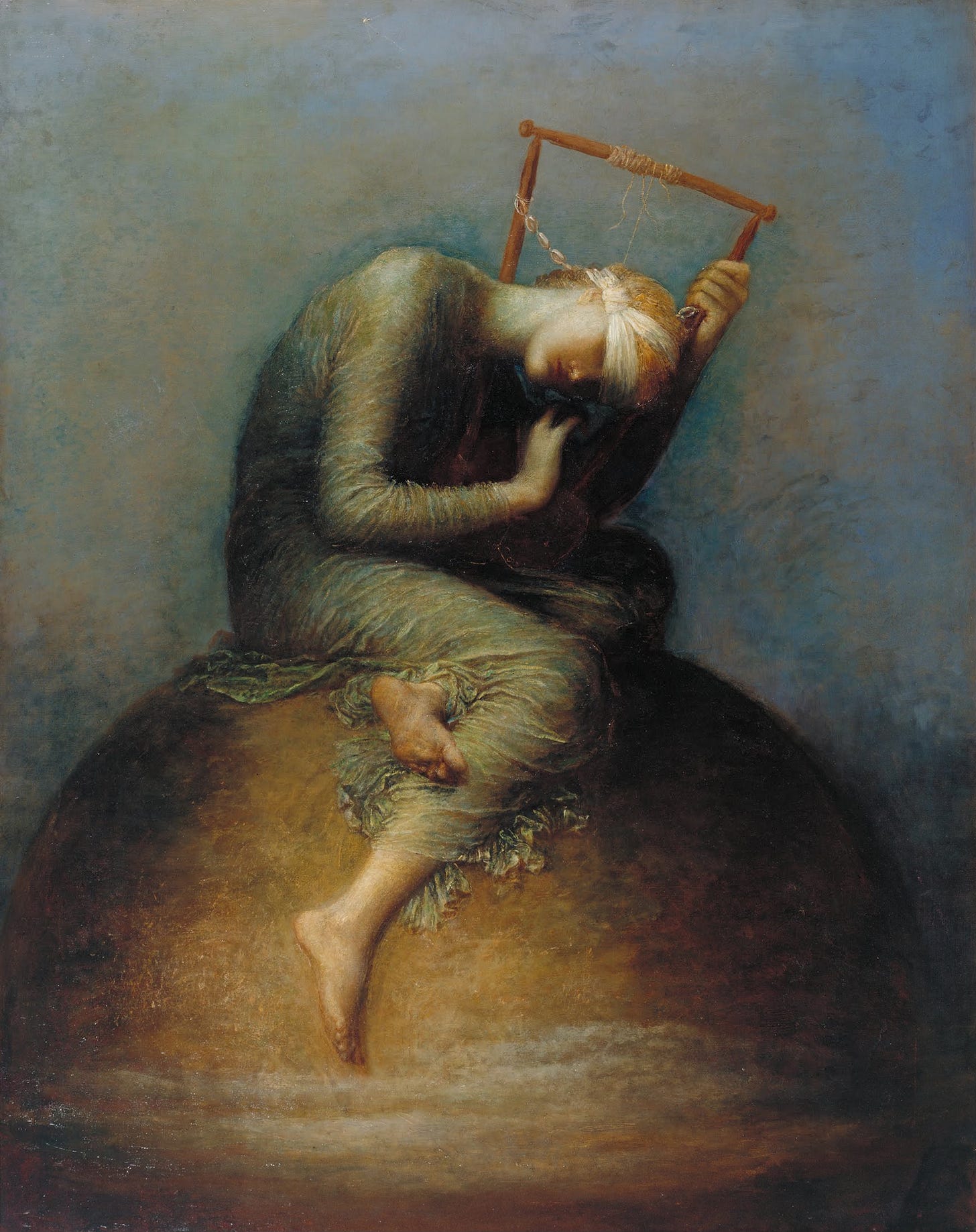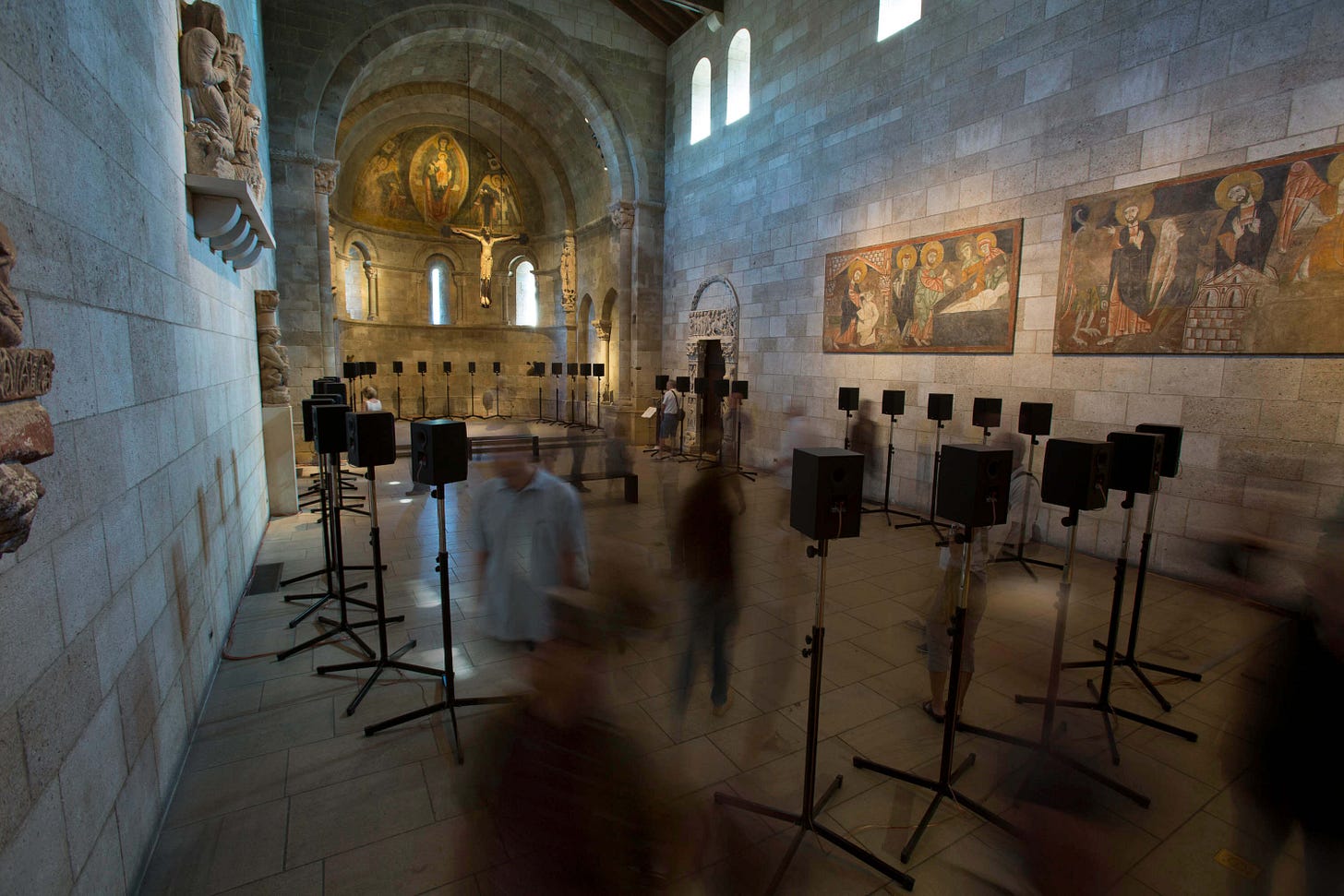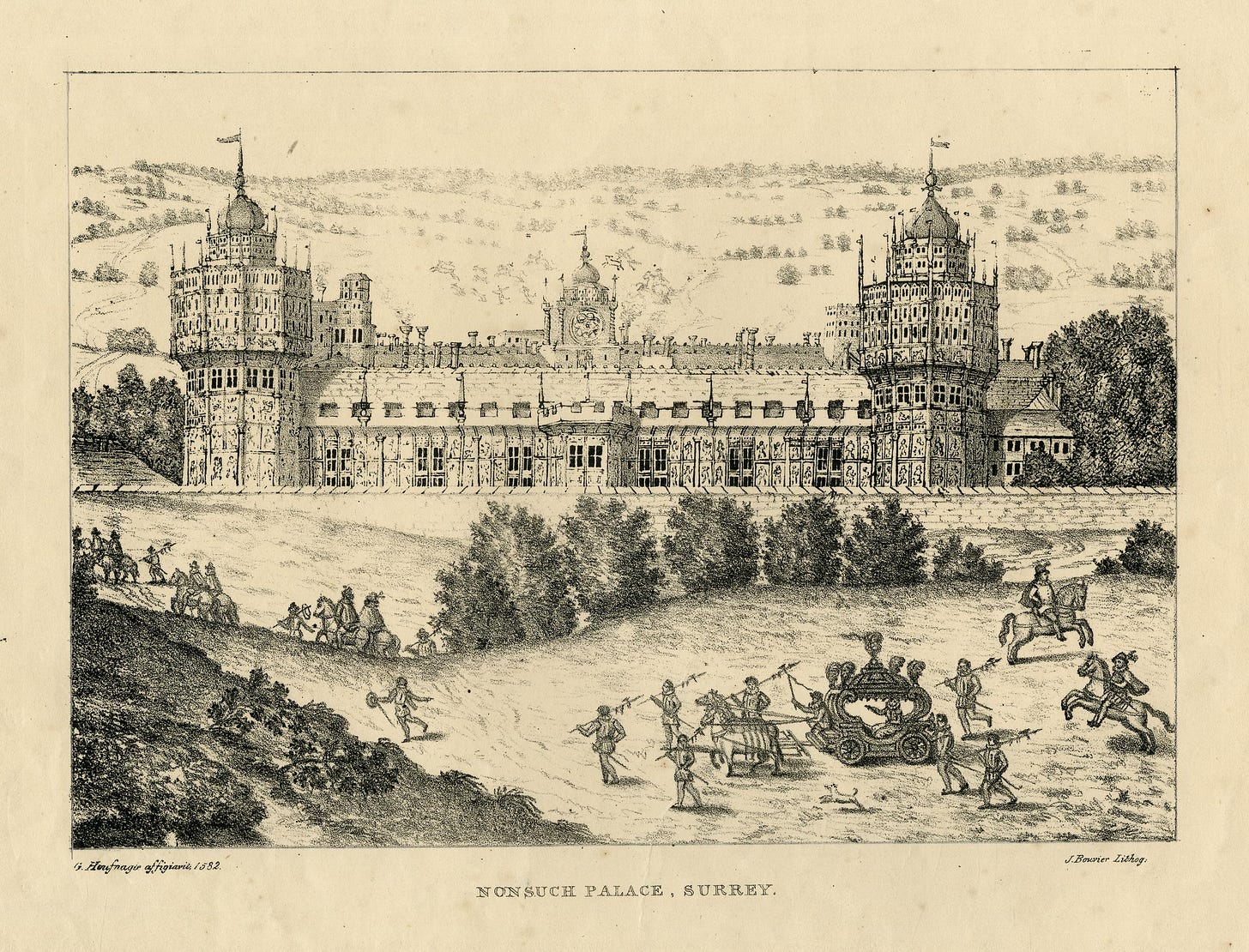Thomas Tallis / Spem in alium (Hope in Any Other)
A prayer of piety and hope reaches across the centuries to guide us to a more peaceful, loving future.

When anyone asks for an off-the-beaten-path destination to explore in New York City, I implore them to visit the Cloisters Museum, the Metropolitan Museum of Art's outpost for medieval European art. Located near the northern tip of Manhattan, the museum (now branded as The Met Cloisters) and its manicured medieval gardens stand among the lush greenery of Fort Tryon Park, complete with serene views of the Hudson River and the picturesque palisades towering over its western shore in New Jersey.
With no streets in sight, and birdsong replacing New York's usual soundtrack of car horns and rumbling subway trains, the Cloisters is one of the few spaces in Manhattan where you can't help but transcend time and place. It's easy to forget you're in a densely populated city, and the slow, considered pace your body naturally adopts to wander the museum's galleries and gardens is more akin to medieval monastic life than the rush of our modern times.
I've made many pilgrimages to the Cloisters, but a particular visit, in September 2013, is one I hold especially close to my heart.
After opening the museum's mammoth oak doors and ascending the stone steps to join the admissions line, I heard the faint strains of a choir coming from the museum's Fuentidueña Chapel, a 12th-century marvel of Romanesque architecture on long-term loan to the Met from the Spanish government. Given the frequency of concerts performed in that space — the chapel's vaulted ceilings and slick stonework provide an ideal acoustic for live music — I thought I had stumbled on a local choir performing period-appropriate music on a sunny Saturday.
But when I entered the gallery, there was no choir to be found. Instead, I saw dozens of speakers installed on tripods around the perimeter of the chapel, bathed in the afternoon light pouring in from windows high above the altar. The space was packed, but unlike a standard concert where everyone sits in rows at a distance from the performers, people were milling about the chapel. Some moved slowly from one speaker to another, others were lying on their backs on the altar steps, their skyward gazes transfixed, or seated on benches with eyes closed. Couples held each other and gently wept.
I had stepped into an installation of The Forty Part Motet by Janet Cardiff, a Canadian artist known for elaborate sound installations. Inspired by a performance of Spem in alium, a 16th-century composition for unaccompanied choir by Thomas Tallis, Cardiff reimagined the work using 40 speakers — one for each voice called for in Tallis's score. Cardiff engaged England's Salisbury Cathedral Choir to make a special recording, where every singer's performance was captured with an individual microphone, so that each speaker in the installation emits the sound of just one voice.
By placing these speakers throughout the chapel, Cardiff gives everyone the chance to play an active role in the performance, something you don't get when the choir is situated on a faraway stage. Here I could get close to one speaker and absorb the sounds of a single performer — not just the music they sang, but their slow intake of breath before an entrance, the crack of tongue against teeth as they formed a consonant, a slight adjustments made to their intonation. Or I could stand between speakers and hear the melodic lines of two singers dance around me.
And for those breathtaking moments when Tallis employs all 40 voices at once, standing in the center of the chapel gave me the chance to swim in a sea of rapturous sound. It didn't take long for me to join those wiping tears from their faces.

"With this piece I want the audience to experience music from the viewpoint of the singers," Cardiff said of the installation.
"Every performer hears a unique mix of the piece of music. Enabling the audience to move throughout the space allows them to be intimately connected with the voices. The sound waves hitting your body from 40 separate speakers, in such a pure way, really affect you emotionally. The sound just goes totally into you. And if it's the right space, it really reverberates in your body."
The Fuentidueña Chapel was absolutely the right space to experience Cardiff's work. And as I made my way home from the Cloisters that afternoon, I couldn't stop thinking about Tallis's work and the overwhelming comfort it conveyed. What was the story behind Spem in alium? How could this music connect a gallery full of hardened New Yorkers to such a state of bliss nearly five centuries after it was written?
One of the most celebrated musicians of the English Renaissance, Thomas Tallis was an organist and composer who provided music for five successive sovereigns, from Henry VIII to Elizabeth I. Tallis held a coveted position, but in this bloodbath of an era in English history, with the country's leaders provoking violent clashes between the Catholic and Protestant churches, life as a court musician — especially one regularly tasked with composing music for religious services — was a dangerous line of work.
But Tallis was a chameleonic composer, able to move between the florid, polyphonic music beloved by the Roman Catholic Church and the austere choral writing demanded by the Protestant monarchs, in which music held a subservient role to its text. For Spem in alium, Tallis turned to a passage from the Book of Judith, a prayer of piety and hope sung by the children of Israel as they await death at the hands of the Assyrian general Holofernes:
I have never placed my hope In any other than you, God of Israel, Who can show both anger and graciousness And absolve all the sins Of suffering man. Lord God, creator of Heaven and Earth Be mindful of our humiliation.
Until recently, historians believed Tallis had written Spem in alium in 1573, to commemorate Elizabeth I's 40th birthday. But this backstory, based on just a few vague extant sources, doesn't make a lot of sense. Elizabeth, who held deeply puritanical views about music, hated the elaborate polyphony of the Catholic Church. And after assuming the throne, she banned the use of Roman liturgical texts, including the Book of Judith. Would an astute composer like Tallis really have dared to provoke the dedicatee of his new work by setting a verboten text in a florid style?
In 2001, American musicologist George Steel made the case for a different timeline for Spem in alium — that Tallis had composed the motet two decades earlier, during the reign of Mary Tudor. As queen, Mary had championed ornate music with complex textures, and her followers regarded her as a modern-day Judith, making Tallis's text a perfect fit for the sovereign. (Shortly after taking the crown in 1553, Mary ordered the decapitation of the Duke of Northumberland, who had convinced Edward VI to choose as his successor Lady Jane Grey, the duke's daughter-in-law, instead of Mary.)
Steel believes Spem in alium was likely commissioned in 1556 — the year Mary turned 40 — by Henry FitzAlan, 12th Earl of Arundel. FitzAlan had just been gifted by the queen the magnificent Nonsuch Palace, a castle built by Henry VIII outside of London that boasted, among its many marvels, two octagonal towers that were five storeys tall. Tallis mirrored this architectural structure in his choral work for 40 voices — eight choirs of five singers each — which was likely performed at Nonsuch with the singers surrounding the audience, each choir positioned against one of the tower's eight walls.
In an age when strong political connections were paramount, FitzAlan couldn't have made a more strategic statement of gratitude to his new queen on her birthday than to commission a motet from England's most popular composer.

As fascinating as Spem in alium's backstory is, it doesn't explain the visceral emotional reaction I and so many others had at the Cloisters. Very few of the 127,000 people who made their way through the installation that fall would have known the work's blood-soaked background, and many probably missed the music's Latin text presented in small type on one wall of the crowded gallery. That leaves Tallis's music, and our experience of it in a public space, as the mystery behind the many tears shed.
Cardiff herself noted how much the music itself affected her:
"I saw the score and how it moved — page after page, it would move, almost like water in a river. ... You can hear the sound move from one choir to another, jumping back and forth, echoing each other, and then experience the overwhelming feeling as the sound waves hit you when all of the singers are singing.
"People need this emotional release. They need to have this ability to be in the moment and feel the presence and spirituality that music like this brings to them."
"To be in the moment" with this work is to embrace its deep sense of communion — not only between singers and listeners, but also among the 40 voices working together as one. Beginning with a single voice from the first choir, each singer enters into the texture on their own, contributing to the ever-growing expansiveness of sound. The increasingly complex counterpoint of the music fosters intimate conversation between voices. Individual lines rise and fall, soaring to new heights in one moment, giving way to silence in the next, until all 40 voices finally resound together for the first time.
Every time we listen to the piece, a new experience takes shape: lines we hadn't previously noted capture our ears, moments of temporary dissonance dissolve in gratifyingly new ways, the rare moments of total silence become more profound. Through the pure spirituality of sound, we experience a direct connection to these voices. They arise, ethereally, from the mouths of 40 speakers, each one representing — like each of us — a single, shimmering golden thread in the vast tapestry of the universe.
Tallis's prayer of piety also serves as a call for hope, a manifestation of our unending human belief in a better tomorrow and our ability to see beacons of light through the thick fog of despair. By reaching across the centuries to connect past and present, present and future, Spem in alium compels us to absorb this music of nourishing calm and use it to cultivate courage and compassion during our own turbulent times. Nearly 500 years — half a millennium — after Tallis composed his score, it continues to serve as an affirming flame, guiding us to a more peaceful, loving future.
Take a listen …
There's an abundance of amazing recordings of this work available, but lately I've gravitated to one from the ORA Singers. The pristine clarity of texture, the sweeping pace of the music, the seamless phrasing as lines move from singer to singer — it's just magnificent.
And for a viewing experience that demands a box of tissues nearby, check out the choir's performance of Spem in alium in the Tate Modern's Turbine Hall. Recorded in September 2020, as the performing arts suffered tremendous losses during the pandemic lockdowns, these 40 singers (socially distanced throughout the Tate's massive space) came together to offer a moment of comfort and calm at a time when we all needed more hope in our lives.
What was your experience listening to Tallis's prayer of piety and hope? I'd love to know. Be sure to leave a comment here or reply to this email. (And if you enjoyed your time here today, would you ever so kindly tap that little heart below? 👇🏼)
Thank you for reading Shades of Blue! This newsletter is free, but paid subscribers help support the 20+ hours of research, writing, editing, and production that goes into every essay. If you look forward to reading Shades of Blue when it arrives in your inbox, please consider becoming a paid subscriber …
… or make a one-time donation through Buy Me a Coffee:







Beautiful.
Met Cloisters is on my list now! Prioritized for this month. Thank you for sharing